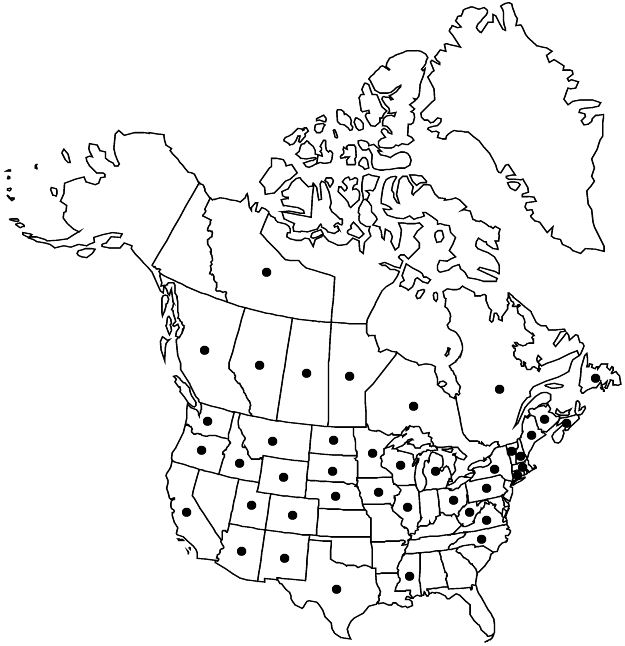Difference between revisions of "Fragaria vesca"
Sp. Pl. 1: 494. 1753.
FNA>Volume Importer |
FNA>Volume Importer |
||
| Line 21: | Line 21: | ||
}}<!-- | }}<!-- | ||
| − | --><span class="statement" id="st-undefined" data-properties=""><b>Plants </b>hermaphroditic (sometimes pistillate in <i></i>subsp.<i> bracteata</i>). <b>Leaves</b> bright green (sometimes darker green in <i></i>subsp.<i> californica</i>), not glaucous, thin, not leathery, not reticulately veined abaxially, terminal tooth of terminal leaflet longer than or equal to adjacent teeth (sometimes equal to or shorter than adjacent teeth in <i></i>subsp.<i> californica</i>). <b>Flowers</b> bisexual or unisexual; hypanthium 11–21.2 mm diam.; petals 5, ± obovate to nearly orbiculate, margins overlapping or distinct. <b>Achenes</b> deeply embedded, in shallow pits, or superficial, yellowish green to reddish brown, 1–1.5 mm; bractlets and sepals clasping, spreading, or reflexed in fruit; torus easily or not easily separating from hypanthium.</span><!-- | + | --><span class="statement" id="st-undefined" data-properties=""><b>Plants </b>hermaphroditic (sometimes pistillate in <i></i></i>subsp.<i><i> bracteata</i>). <b>Leaves</b> bright green (sometimes darker green in <i></i></i>subsp.<i><i> californica</i>), not glaucous, thin, not leathery, not reticulately veined abaxially, terminal tooth of terminal leaflet longer than or equal to adjacent teeth (sometimes equal to or shorter than adjacent teeth in <i></i></i>subsp.<i><i> californica</i>). <b>Flowers</b> bisexual or unisexual; hypanthium 11–21.2 mm diam.; petals 5, ± obovate to nearly orbiculate, margins overlapping or distinct. <b>Achenes</b> deeply embedded, in shallow pits, or superficial, yellowish green to reddish brown, 1–1.5 mm; bractlets and sepals clasping, spreading, or reflexed in fruit; torus easily or not easily separating from hypanthium.</span><!-- |
-->{{Treatment/Body | -->{{Treatment/Body | ||
| Line 76: | Line 76: | ||
|publication year=1753 | |publication year=1753 | ||
|special status=Selected by author to be illustrated | |special status=Selected by author to be illustrated | ||
| − | |source xml=https://jpend@bitbucket.org/aafc-mbb/fna-data-curation.git/src/ | + | |source xml=https://jpend@bitbucket.org/aafc-mbb/fna-data-curation.git/src/f6b125a955440c0872999024f038d74684f65921/coarse_grained_fna_xml/V9/V9_439.xml |
|subfamily=Rosaceae subfam. Rosoideae | |subfamily=Rosaceae subfam. Rosoideae | ||
|tribe=Rosaceae tribe Potentilleae | |tribe=Rosaceae tribe Potentilleae | ||
Revision as of 20:37, 24 September 2019
Plants hermaphroditic (sometimes pistillate in subsp. bracteata). Leaves bright green (sometimes darker green in subsp. californica), not glaucous, thin, not leathery, not reticulately veined abaxially, terminal tooth of terminal leaflet longer than or equal to adjacent teeth (sometimes equal to or shorter than adjacent teeth in subsp. californica). Flowers bisexual or unisexual; hypanthium 11–21.2 mm diam.; petals 5, ± obovate to nearly orbiculate, margins overlapping or distinct. Achenes deeply embedded, in shallow pits, or superficial, yellowish green to reddish brown, 1–1.5 mm; bractlets and sepals clasping, spreading, or reflexed in fruit; torus easily or not easily separating from hypanthium.
Distribution

North America, Mexico, Eurasia, introduced in West Indies, South America, Pacific Islands.
Discussion
Subspecies 4 (4 in the flora).
Selected References
None.
Lower Taxa
Key
| 1 | Fruiting tori easily separating from hypanthia, tori globose to ± oblong; achenes superficial or in shallow pits; leaves green to dark green, terminal leaflet blades ± round or slightly ovate-rhombic, length/width 0.9–1.3, teeth: relative number 0.4–0.9, relative size 1–2.3; bractlets and sepals spreading or reflexed in fruit. | Fragaria vesca subsp. californica |
| 1 | Fruiting tori easily or not easily separating from hypanthia, tori globose, subglobose, oblong-ovoid, or elongate-conic (slightly oblate or conic); achenes superficial, in shallow pits, or deeply embedded; leaves green to bright green, terminal leaflet blades ovate or obovate to slightly rhombic, length/width 1.1–1.8, teeth: relative number 0.2–0.6, relative size 1.5–4; bractlets and sepals clasping, spreading, or reflexed in fruit | > 2 |
| 2 | Flowers usually bisexual, sometimes pistillate, 15.3–23.8 mm diam.; petals usually white, sometimes pinkish; bractlets clasping or spreading to slightly reflexed, sepals clasping in fruit; achenes in shallow pits or deeply embedded; tori usually not easily separating from hypanthia. | Fragaria vesca subsp. bracteata |
| 2 | Flowers bisexual, 12–20.5 mm diam.; petals white; bractlets and sepals spreading to reflexed in fruit; achenes superficial or in shallow pits; tori easily separating from hypanthia | > 3 |
| 3 | Fruiting tori globose or subglobose (often slightly oblate or conic); leaves bright green; achenes superficial or in shallow pits. | Fragaria vesca subsp. vesca |
| 3 | Fruiting tori elongate-conic (often somewhat pointed); leaves green to bright green; achenes superficial. | Fragaria vesca subsp. americana |